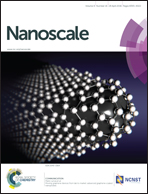Remarkable influence of slack on the vibration of a single-walled carbon nanotube resonator
Abstract
We for the first time quantitatively investigate experimentally the remarkable influence of slack on the vibration of a single-walled carbon nanotube (SWCNT) resonator with a changeable channel length fabricated in situ inside a scanning electron microscope, compare the experimental results with the theoretical predictions calculated from the measured geometric and mechanical parameters of the same SWCNT, and find the following novel points. We demonstrate experimentally that as the slack s is increased from about zero to 1.8%, the detected vibration transforms from single-mode to multimode vibration, and the gate-tuning ability gradually attenuates for all the vibration modes. The quadratic tuning coefficient α decreases linearly with  when the gate voltage Vdcg is small and the nanotube resonator operates in the beam regime. The linear tuning coefficient γ decreases linearly with
when the gate voltage Vdcg is small and the nanotube resonator operates in the beam regime. The linear tuning coefficient γ decreases linearly with  when Vdcg has an intermediate value and the nanotube resonator operates in the catenary regime. The calculated α and γ fit the experimental values of the even in-plane mode reasonably well. As the slack is increased, the quality factor Q of the resonator linearly goes up, but the increase is far less steep than that predicted by the previous theoretical study. Our results are important to understand and design resonators based on CNT and other nanomaterials.
when Vdcg has an intermediate value and the nanotube resonator operates in the catenary regime. The calculated α and γ fit the experimental values of the even in-plane mode reasonably well. As the slack is increased, the quality factor Q of the resonator linearly goes up, but the increase is far less steep than that predicted by the previous theoretical study. Our results are important to understand and design resonators based on CNT and other nanomaterials.


 Please wait while we load your content...
Please wait while we load your content...